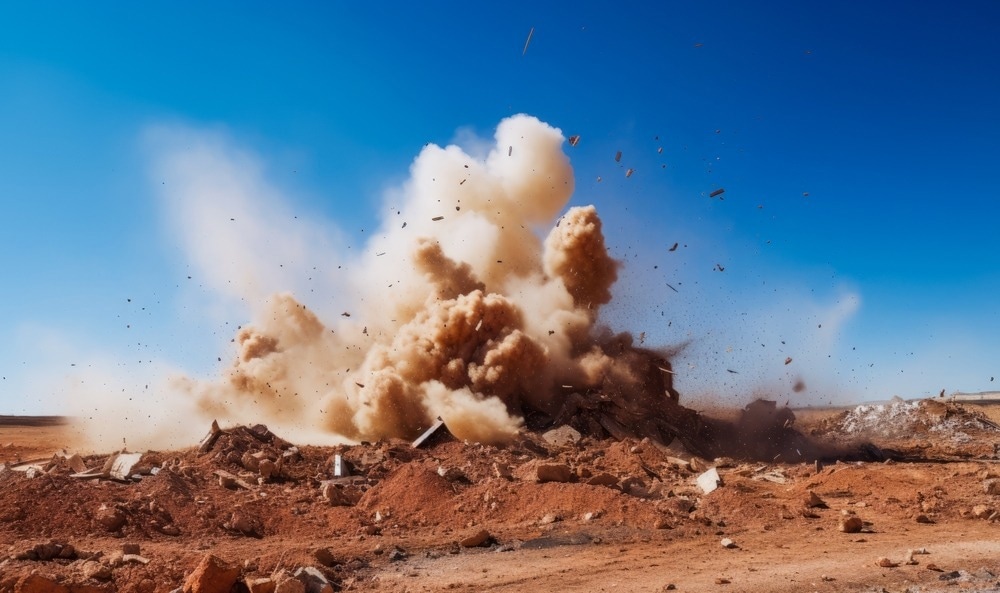Dust explosions can have catastrophic consequences, including irreversible damage and tragic loss of life. An ignition source, such as electrical or thermal equipment, can trigger an explosion when introduced into an environment with a high concentration of dust, typically within confined spaces like buildings or vessels.

Image Credit: Hussain Warraich/Shutterstock.com
The extreme heat generated increases pressure, ultimately leading to an explosion. In such scenarios, visibility is significantly reduced.
Unfortunately, these incidents are not rare. Historical records show that nearly every industry has experienced dust explosions, with numerous cases occurring in recent years.
Many industries that store, handle, and process materials inherently produce dust. In the food processing sector, various substances contribute to dusty environments. Major industries include sugar and flour processing, as well as grain handling and other powdered products such as instant coffee, custard, and soup.
Outside of food production, large-scale processing also takes place in wood and chemical plants, where considerable volumes of powder are managed. This dust is often a by-product of stages such as coating, cutting, mixing, or transportation. Similarly, recycling facilities deal with substantial amounts of plastic and paper dust.
The agricultural sector relies on numerous processes involving potentially hazardous dust levels. These include operations at fertilizer plants, industrial composting sites, and expansive storage facilities like grain elevators and silos.
Coal mining presents a similar risk. Processing methods generate coal dust in ways comparable to other industrial processes. Dust is dispersed during rock crushing, and transportation of rock often exacerbates the issue.
Additionally, coal mining releases methane gas, which has accumulated in coal seams over millennia. Methane is highly flammable and poses a significant explosion risk.
Cygnus 1 Ex
Various ignition sources may inadvertently be introduced into hazardous environments during essential maintenance activities. One such source is ultrasonic testing equipment, which is crucial for conducting maintenance checks on machinery involved in these processes.
While maintenance is vital for ensuring safety and can help prevent dust cloud formation by addressing leaks, it is imperative that the maintenance equipment itself is safe for use in these hazardous environments.
The Cygnus 1 Ex is a corrosion thickness gauge certified for safe use in locations where there is a risk of fire or explosion due to the presence of ignitable or flammable substances—including gases, vapours, and dust—at concentrations high enough to form an explosive mixture.
This safety is made possible because the Cygnus 1 Ex is Intrinsically Safe. For devices like this that contain electronic components (including batteries), intrinsic safety technology limits the system's energy so that no arc or spark can be generated, and no part can reach temperatures capable of igniting a hazardous atmosphere.
This holds true under both normal and fault conditions, with low power levels and minimal stored energy.
Cygnus 1 Ex features an Intrinsically Safe Design, which includes:
- Limited output energy to prevent ignition of explosive atmospheres
- Anti-static enclosure to mitigate static electricity discharge
- Multiple redundant safety components
- No high surface temperatures generated in the event of damage or fault, thus preventing ignition of an explosive atmosphere
The term Intrinsically Safe is part of the Ex Protection Concept, which is used globally to determine which facility zones equipment is suitable for. The “Ex” designation refers to equipment certified for explosive atmospheres, as recognized under IECEx, ATEX, and North American safety systems.
Intrinsically safe equipment like the Cygnus 1 Ex can be used in any certified Zone or Division, provided it meets the required Equipment Protection Level (EPL).
For dust environments, the Cygnus 1 Ex is certified for Zones 21 and 22:
- Zone 21: Areas where combustible dust is occasionally present
- Zone 22: Areas where combustible dust is not typically present, but may appear for short periods
Notable Features
The Cygnus 1 Ex ultrasonic thickness gauge offers a major step forward in safe structural inspection within hazardous environments. Users have described it as “versatile, multifunctional, robust, and intuitive.”
This intrinsically safe gauge provides superior control and flexibility, eliminating the need for plant shutdowns or Hot Work Permits.
Equipped with three measuring modes and a selection of probes, it can measure various materials and metals—even in cases of severe corrosion or with protective coatings up to 20 mm thick—saving significant time and cost associated with removing coatings.
Advanced users will benefit from the Manual Measurement Mode, which simplifies readings in difficult areas like heavy corrosion.
Like a flaw detector, users can manually adjust two gates, position them anywhere on the A-scan, alter gate height, start point, and width, and take measurements from a gate or between gates.
Time-Controlled Gain (TCG) also enables users to introduce different gain levels to enhance weaker echoes.
For data storage and analysis, the gauge offers full flexibility. Its comprehensive data logging supports linear logging, templates, and both 2D and 3D grid formats, with 16 grid patterns and annotation options.
Radial Points allow further investigation in areas of interest or heavy corrosion by enabling up to 12 additional measurements around a primary reading.

This information has been sourced, reviewed and adapted from materials provided by Cygnus Instruments Ltd.
For more information on this source, please visit Cygnus Instruments Ltd.